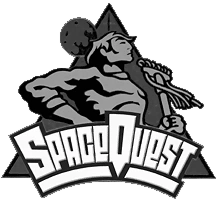AGI (Adventure Game Interpreter) was the development tool used by Sierra Online to create their early adventure games.
The original King's Quest engine and language (named Game Assembly Language or *.gal by its designer, Arthur Abraham) was developed by Sierra to to showcase the technology of the IBM PCjr. AGI, originally developed by IBM, was donated to Sierra when it was unable to finish the project due to the dismissal of its main designer.
The first game to use the AGI engine was King's Quest I, released in 1984. There were also a few games made with AGI that were not adventure games.
When it was first used, in the mid-1980s, AGI was very innovative and made impressive use of the technology available at the time. Later versions were adapted to use 16 color EGA graphics and the Adlib soundcard.
By the end of the 80s, however, AGI's 160×200 resolution began to look outdated and it couldn't keep up with newer developments such as mice, which were used extensively by the SCUMM engine of competitor Lucasfilm Games. In 1990, Sierra abandoned AGI and started using the SCI (Sierra Creative Interpreter) engine for their adventure games.
Sarien (Sierra AGI resource interpreter engine) is a portable, open-source re-implementation of Sierra's AGI.
List of AGI games
(rough chronological order)
- Kings Quest 1 - Quest for the Crown (1984)
- Kings Quest 2 - Romancing the Throne (1985)
- The Black Cauldron (1986)
- Donald Duck's playground (1986)
- Kings Quest 3 - To Heir is Human (1986)
- Mickey's Space Adventure (1986)
- Space Quest 1 - The Sarien Encounter (1986)
- Winnie The Pooh - In the Hundred-Acre Woods (1986)
- Leisure Suit Larry 1 - In the Land of the Lounge Lizards (1987)
- Mixed Up Mother Goose (1987)
- Police Quest 1 - In pursuit of the Death Angel (1987)
- Gold Rush! (1988)
- Manhunter 1 - New York (1988)
- Space Quest 2 - Vohaul's Revenge (1988)
- Kings Quest 4 - The Perils of Rosella (1988) *
- Manhunter 2 - San Francisco (1989)
* King's Quest IV was simultaneously produced and published in the AGI and SCI engines. The main advantages of SCI are a higher resolution (320x200 rather than 160x200 in AGI), sound card support, mouse support, and a more versatile scripting system. It was made because Sierra supposed that contemporary low-end systems would be unable to run the SCI version, thus requiring a 'lighter' version of the game. However, sales figures proved them wrong, and the AGI version was discontinued almost instantly. Because of its rarity, the AGI version could be considered a collector's item.
